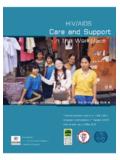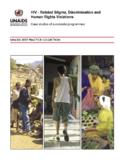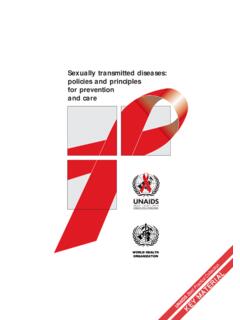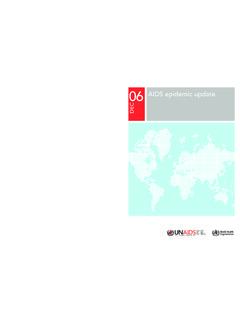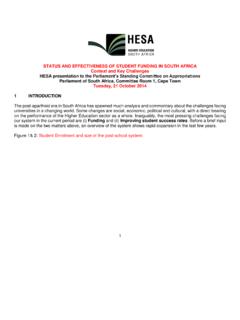Transcription of the challenges of HIV AIDS STDs
1 FacingFacingAIDSAIDSSTDsSTDsHIVHIVthe challenges ofUnderstanding gender issuesStrategies to dUnderstanding gender issuesStrategies to deal with HIV / AIDSI nterventions that workPersonal teal with HIV / AIDSI nterventions that workPersonal testimoniesAdditional readingestimoniesAdditional readinga responsegender-based::ACKNOWLEDGEMENTSTh e Royal Tropical Institute, Southern Africa aidsInformation Dissemination Service and WorldHealth Organization, Global Programme on aids , would like to thank the following organizations fortheir contributions during production of this publication:abia(Brazil), ahrtag(United Kingdom), aspane(Mexico), Chiang Mai University(Thailand), Christian Health Association of Kenya (Kenya), Community aidsCentreJohannesburg (South Africa), Faculty of Social Science, University of Natal (South Africa),Food and Agriculture Organization of the United Nations (Italy), Fundaci n para Estudio eInvestigaci n de la Mujer (Argentina), Fundaci n sida(Puerto Rico), gap-sirmce(India),gapaS o Paulo (Brazil), Grupo de Incentivo a Vida S o Paulo (Brazil), Health Force (usa),Health Project for Tribal People (Thailand), hivAssociation (The Netherlands)
2 , icad(Canada), Instituto de Educaci n y Salud (Peru), iser(Brazil), International hiv/aidsAlliance (United Kingdom), International Planned Parenthood Federation, WesternHemisphere Region (ukand usa), Kabalikat (The Philippines), Kenya aidsngoConsortium(Kenya), kuleana(United Republic of Tanzania), London Department of Health (UnitedKingdom), mccs(Brazil), Medical Mission Institute (Germany), Movimiento Paulina Luisi(Uruguay), napham(Malawi), National aidsControl Organization (India), National aidsTrust (United Kingdom), National Women and hivProject (Canada), Red Argentina deMujeres Viviendo con vih/sida(Argentina), Scripture Union Aid for aids (Zimbabwe), tampep(The Netherlands), taso(Uganda), Toque de Mulher (Brazil), University of Natal(South Africa), Women and aidsResearch Program, International Center for Research onWomen (usa), ywcaCouncil of Zambia (Zambia)Editorial Advisory CommitteeTeresita Bagasao, Kabalikat ngPamilyang Pilipino (The Philippines); Marge Berer,Reproductive Health Matters (United Kingdom); Mabel Bianco, Fundaci n para Estudio eInvestigaci n de la Mujer (Argentina).
3 Michele Bird, International Community of WomenLiving with hiv/ aids (United Kingdom); Aine Costigan, Interagency Coalition on aidsandDevelopment (Canada); Nel Druce, ahrtag(United Kingdom); Jacques du Guerny, Chief,Population Programme Service, Women s and People s Participation Division, fao(Italy);Jane Galvao, abia(Brazil); Hannah Jansen, Positive Women Section, hivAssociation (TheNetherlands); Ethel Kapyepye, unv Mansa (Zambia); Olusegun Obasanya, Federal Ministryof Health Lagos (Nigeria); Sunanda Ray, Women and aidsSupport Network (Zimbabwe) facing the challenges of hiv/ aids / stds : a gender-based responsePublished by the Royal Tropical Institute (kit), Mauritskade 63, 1092adAmsterdam, TheNetherlands; Southern Africa aidsInformation Dissemination Service (safaids), 17 Beveridge Road, Avondale, Harare, Zimbabwe; and World Health Organization, GlobalProgramme on aids , ch1211 Geneva 27, Switzerland, with financial support from theSasakawa Memorial Health Foundation.
4 Copyright: kit, safaidsand World Health Organization, 1995isbn: 9068327089; second printingThis publication is not a formal publication of the World Health Organization (who); allrights are reserved by kit, safaidsand who. This document may be freely reviewed,abstracted, reproduced or translated with acknowledgement, in part or in whole, but maynot be sold or used in conjunction with commercial purposes. The authors alone areresponsible for the views expressed in the articles and the publications listed. Distributed free by kit, safaidsand the whoGlobal Programme on written/compiled by: Maria de Bruyn, Helen Jackson, Marianne Wijermars, VirginiaCurtin Knight and Riet BerkvensPhotographs from: Roel Burgler, G.
5 Diez, kit, whoDesign: OptimaForma, The NetherlandsPrinted by: ssn, The NetherlandsEXECUTIVE SUMMARY This publication aims to provide policy-makers, planners and programme implementerswith information and ideas onhow to incorporate a gender-based response to hiv/aidsandstds into their policies outlining the globalepidemiology of hivinfection,aidsand stds , it explores theconcepts of gender and a gender-based response. The focus of thenext section is the impact of theepidemic, elaborating on howgender-related factors affect hiv-infection risks and obstacles toprevention and care. Then gender-based responses and strategies aresuggested and testimonies andbrief descriptions of programmesand interventions personalize thetext, show the impact of genderinequality on female and male riskand coping, and provide examplesof effective conclude, a checklist isprovided for assessing the gender-based focus of existing or plannedprogrammes and interventions.
6 1. Why gender and hiv/ aids / stds ?2 How extensive are hiv/ aids and stds ?4 What does a gender-based response involve?7 Why do hiv/ aids /stdsaffect women more?10 Can women and men reduce risks and share responsibilities?23 How gender sensitive is your work?43 References46 Additional reading48 List of contributors 51 Invitation to comment on this publication52 Contents One of the most striking features of the response to the hivepidemic to date is how few ofthe policies and programmes wehave developed relate to women slife situations. The daily lives ofwomen and the complex networkof relationships and structureswhich shape them are well knownto women and well this, our theories,research agendas, policies andprogrammes have not beengrounded in and informed bythese experiences.
7 EAs the hiv/ aids epidemic and sexually transmitted diseases ( stds ) con-tinue to advance worldwide, we are learning ever more about how theyaffect individuals, households, families, communities, organizationsand nations. The individual loss has been enormous, particularly inthose countries and regions affected early on. aids is increasingly recog-nized in developing countries as a serious concern for socioeconomicdevelopment as a whole. Its impact is seen in family and communitystructures and relationships and in sectors as varied as education,employment, health care, social welfare, agriculture and the consequences are already apparent.
8 In highly affectedcountries, the business sector is experiencing increased absenteeism asemployees fall ill, care for the sick or attend funerals. Loss of experiencedand skilled workers in the formal and informal sectors may lead to lowerproductivity, savings and investments. In subsistence and small-scaleagriculture, loss of labour may result in changes in farming patterns andfood shortages. Strategies to prevent the spread of hivhave focused on the promotion ofcondom use, reduction of numbers of sexual partners and treatment ofstds [2]. Many of these responses, however, have failed to address social,economic and power relations between women and men, among menand among women.
9 These relationships, together with physiological dif-ferences, determine to a great extent women s and men s risk of infec-tion, their ability to protect themselves effectively and their respectiveshare of the burdens of the epidemic: Women are physiologically more vulnerable to hiv infection thanmen. Young women are especially at risk and aids death rates are high-est in women in their 20s. Stereotypes related to hiv/ aids and stds and their association withmarginalized groups ( , sex workers) contribute to blaming women forthe spread of hiv. Fear of stigmatization inhibits people from taking pre-ventive measures and leads women and men to assess their own risksinadequately.
10 Moreover, many ideas and expectations regarding maleand female (sexual) behaviour neither encourage men to act responsiblyand protect themselves and their partners from infection nor stimulatewomen to challenge notions of female inferiority and social structureswhich keep them vulnerable. Low social status and economic dependence prevent many women .2. Whygender andHIV/ aids / stds ?and young people ( , street-children) from controlling their own little negotiating power, they are often unable to insist on safer sex;disproportionately poor, they may have little choice other than to bartersex for survival. As society s traditional care-givers, women carry the main psy-chosocial and physical burdens of aids care.
